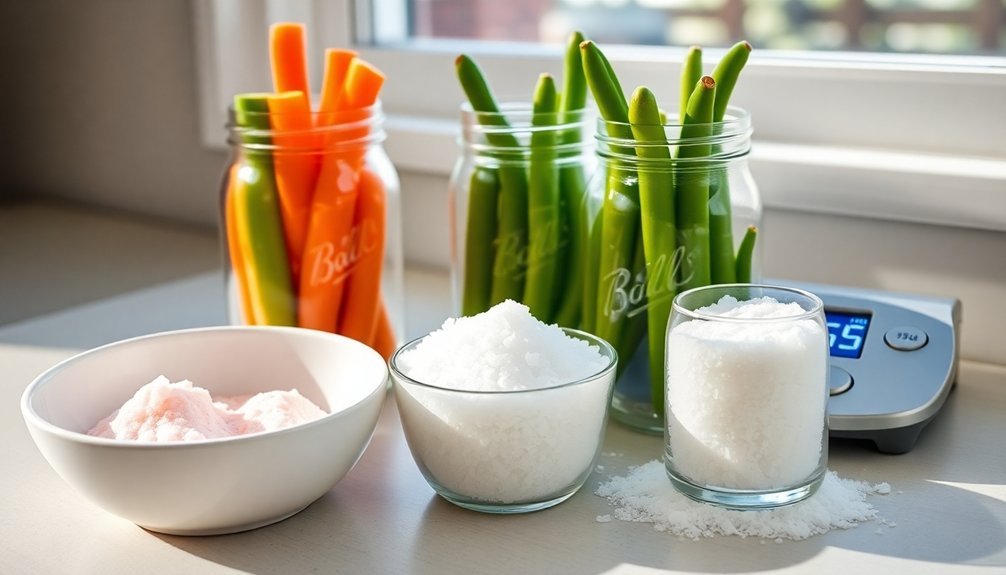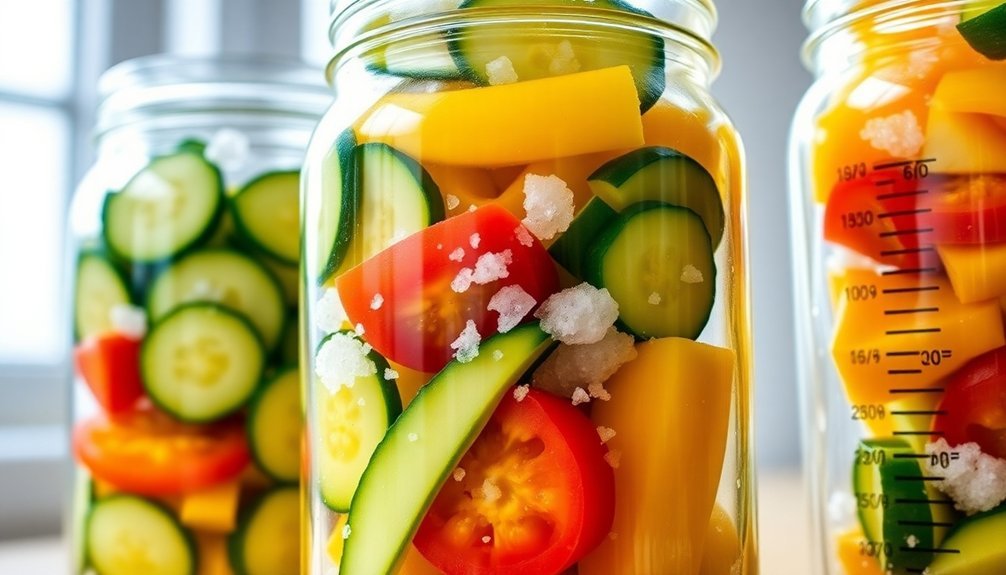You'll find three reliable salt ratios that work best for preserving your summer produce, depending on your climate conditions. For high-humidity environments, use a 1:3 salt-to-produce ratio and add 5% extra salt to combat moisture. In extreme heat, opt for a 1:2 ratio and store your preserved goods in cool, dark spaces. For areas with variable weather, a 1:2.5 ratio offers the perfect balance while using airtight containers. While these ratios serve as your foundation, understanding how to adapt them to your specific preservation needs will transform you into a preservation expert.
Everyday Summer Vegetable Fermentation

From among the many preservation methods available today, fermenting summer vegetables stands out as both a practical and rewarding technique.
Regular burping of jars during fermentation prevents excessive gas buildup and potential container damage.
For most summer vegetables like garlic, beetroot, broccoli, and cabbage, you'll want to use a 2% salt concentration to achieve ideal fermentation.
To calculate the right amount of salt, weigh your produce and water together, then multiply by 2.5% to reach approximately 2.44% total salt concentration.
You'll need to use kosher or sea salt, as they're perfect for fermentation due to their coarse texture and lack of additives.
Before you begin, sanitize your jars and equipment by immersing them in boiling water.
When working with vegetables that naturally release moisture, like cabbage, you can simply sprinkle them with 1.5 to 2% of their weight in salt.
For vegetables that need additional liquid, create a brine using a 5% ratio of salt to water (50 grams per liter).
Remember to keep all produce fully submerged in the brine and maintain temperatures between 64°F and 75°F for the best results.
Lower salt concentrations will speed up fermentation, while higher ones help maintain crunchiness.
Long-Term Curing With Salt
Salt curing stands as one of humanity's oldest and most reliable preservation methods, fundamentally different from quick fermentation techniques.
When you're planning to cure produce for long-term storage, you'll need to understand the core mechanism: salt draws moisture out of cells while replacing it within the tissue, creating an environment where harmful bacteria can't thrive.
For vegetables, you'll want to choose between two primary methods. The dry curing method works well when you apply salt directly to your produce, while wet brining involves submerging items in a salt solution. Just like with meat curing, testing for doneness requires checking the texture through touch.
If you're new to curing, start with the equilibrium method – it's more controlled and helps you avoid over-salting. You'll calculate the salt based on your produce's weight, typically using 2-3% for vegetables.
Remember that several factors will affect your curing process. The thickness of your produce, environmental temperature, and humidity all play significant roles.
You'll need to adjust your curing time accordingly. When done correctly, your salt-cured vegetables can last 6-12 months in proper storage conditions, providing you with preserved produce long after summer ends.
Climate-Smart Salt Preservation

While traditional salt preservation methods remain effective, climate change has transformed how we approach food preservation techniques. You'll need to adapt your preservation methods to account for increasingly unpredictable weather patterns and temperature fluctuations. Understanding ideal salt ratios in different climate conditions is essential for successful preservation. The industry's shift to sustainability makes these adaptations even more critical for home food preservation.
| Climate Condition | Salt Ratio (by weight) | Storage Tips |
|---|---|---|
| High Humidity | 1:3 salt to produce | Use controlled environment, add extra 5% salt |
| Extreme Heat | 1:2 salt to produce | Store in cool, dark place, check moisture levels daily |
| Variable Weather | 1:2.5 salt to produce | Use airtight containers, monitor humidity |
| Standard Climate | 1:4 salt to produce | Follow traditional methods, adjust as needed |
To maximize preservation success in changing climates, you'll want to implement climate-smart techniques. Start by measuring humidity levels in your storage area and adjusting salt ratios accordingly. If you're experiencing frequent temperature fluctuations, consider using controlled environments like hoop greenhouses. For best results, combine salt preservation with other methods like fermentation, which creates beneficial bacteria that help preserve food even in challenging conditions. Remember to monitor water activity levels – keeping them below 60% guarantees proper preservation regardless of external climate conditions.
Frequently Asked Questions
Can I Mix Different Types of Salt During Fermentation?
Yes, you can mix different types of salt during fermentation. It won't affect your results as long as you maintain the correct total salt concentration. What matters most is getting your overall salt percentage right.
How Do I Adjust Salt Ratios When Using Pre-Salted or Processed Vegetables?
First, weigh your pre-salted vegetables and check their existing salt content. Then subtract that amount from your recipe's total salt requirement. You'll need to adjust downward to maintain the ideal 2-5% concentration.
Should Salt Ratios Change When Fermenting Fruits Versus Vegetables?
Yes, you'll need higher salt ratios for fruits than vegetables. Use 3-4% salt concentration for most fruits, while vegetables typically need 2-3%. Fruits' higher sugar content requires more salt for proper fermentation.
Does Altitude Affect the Recommended Salt Ratios for Fermentation?
You don't need to adjust salt ratios for altitude in fermentation. While altitude affects microbial activity, your standard salt percentages will work just fine. Keep using 2-2.5% for vegetables and follow normal guidelines.
Can I Reuse Fermentation Brine for New Batches of Vegetables?
Yes, you can reuse fermentation brine for new batches. Add 1/2 cup of old brine to a quart jar of fresh vegetables. It'll speed up fermentation by introducing beneficial bacteria. Just make sure it's fresh and clear.
In Summary
Now you're equipped with three reliable salt ratios to preserve your summer bounty. Whether you're fermenting everyday vegetables at 2-3%, curing for long-term storage at 5-7%, or adapting to warmer climates with 8-10% salt, you'll keep those garden-fresh flavors alive well beyond the growing season. Start small, trust your senses, and don't be afraid to experiment with these time-tested preservation methods.





Leave a Reply